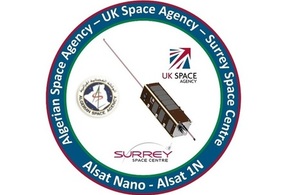First colour image for joint UK and Algerian CubeSat
AlSat Nano, a UK-Algeria CubeSat mission, has captured its first full colour image following its launch in September 2016.

Alsat Nano mission logo.

Image taken from space of the Arkhangelsk Oblast region, on the North West coast of Russia. Credit: Alsat Nano mission, Open University, December 2016.
The image was taken by the Open University C3D2 instrument’s wide field camera on 3rd December, 2016, over the Arkhangelsk Oblast region, on the North West coast of Russia. It was captured under twilight conditions at dawn, showing the coastline to the right, and a brief winter sunrise over the arctic region with a deep red-brown hue. Through the cloud cover there is evidence of hills and snow on mountains, and mist in the river valleys. The object in the foreground is the Oxford Space Systems Ltd AstroTubeTM Boom payload, also carried on board the spacecraft.
This marks an important milestone for the mission as all core payloads have now been commissioned successfully, paving the way for further scientific and commercial exploitation.
Dr Chris Castelli, UK Space Agency Director of Programmes said:
Successfully delivering this joint UK-Algeria mission from payload selection to launch readiness in 18 months is a great achievement from all programme partners. As this latest image demonstrates, mission operations are going from strength to strength, validating cutting edge UK space technology and our open approach to working with international partners.
AlSat Nano is Algeria’s first CubeSat mission and shows the capability of UK technology in partnership with industry and academia. With a spacecraft the size of a shoebox yet featuring all the core subsystems of much larger satellites, the programme demonstrates how CubeSats can be assembled quickly and launched at a fraction of the cost. This will help Algeria strengthen its domestic space technology capability by giving their scientists and engineers first-hand experience of spacecraft operations.

Alsat Nano image overlayed on Google Maps. Credit: Alsat Nano mission, Open University, December 2016. Map credit: Google Maps.
Dr Abdewahab Chikouche, Director of Space Programmes at Algerian Space Agency, said:
The Alsat-1N project is a concrete example of the success of our cooperation with UKSA. This project, very enriching from the scientific and technological point of view, allowed ASAL engineers to progress in the integration and testing of nanosatellites and acquire autonomy in its operation. This project will enable Algerian researchers and academics to strengthen national capabilities in advanced space technology.
Approximately half of the spacecraft’s volume was made available as part of an open call to the UK CubeSat community as a free flight opportunity for self-funded payloads. AlSat Nano stuck to a tight development schedule, with less than 18 months between payload selection and flight readiness.
Prof Guglielmo Aglietti, Director of Surrey Space Centre said:
AlSat Nano has been an exciting project for the Surrey Space Centre to be leading. Educational and research elements, and the technology knowledge transfer with the Algerian Space Agency were key parts of this project. Additionally, the development of this nanosatellite platform has been a great opportunity to work with UK payload providers, who are demonstrating some exciting new technologies.
Notes to editors:
AlSat Nano is a joint nanosatellite mission between the UK Space Agency and Algerian Space Agency (ASAL) as part of an on-going initiative to enhance collaboration. UK Space Agency has funded the design, build and verification of the spacecraft at Surrey Space Centre (SSC), University of Surrey, as a hands-on learning exercise for Algerian postgrad students to demonstrate the practical elements of low cost space technology. ASAL has provided the launch, and operations are being undertaken in Algeria by ASAL operators trained at SSC.
The three selected payloads on AlSat Nano are:
C3D2
A highly customisable CubeSat camera suite offering three fields of view and innovative on-board software processing capabilities. The payload is also a remote experiment of the OpenSTEM Labs - a suite of remote experiments that supports distance learning students studying science and engineering. C3D2 will offer these students the chance to operate a real payload on an orbiting spacecraft. The payload development is led by the Open University Centre for Electronic Imaging with sensor hardware provided by e2v Ltd and electronics from XCAM Ltd.
Thin Film Solar Cell
A novel solar cell structure which is directly layered on cover glass just 1/10th of a millimetre thick. Effects from the space environment will be measured, with the aim of allowing the organisations involved a route to product development and commercial exploitation of this technology. This project is led by the Swansea University Centre for Solar Energy Research with contributions from the University of Surrey, Qioptiq Ltd and Surrey Satellite Technology Ltd.
AstroTube Boom
A retractable CubeSat-compatible boom which should be able to deploy up to 1.5 metres in length from a volume around the size of a business card holder. This technology would enable CubeSats to carry out a greater range of science experiments that require sensors to be held as far away from the spacecraft as possible to reduce interference, and could also form the basis of de-orbit systems for future missions. The payload also carries a magnetometer, one of the most compact of its class, to carry out measurements of the Earth’s magnetic field, and RadFET radiation monitors. The payload is led by Oxford Space Systems Ltd, collaborating with partners including the Science and Technology Facilities Councils RAL Space and Bartington Instruments Ltd.